)
where the L – level of hydration;
τ – time; k and B – constants.
Fig.3.4. Schematic image of the reactive
with water grain
Level of hydration determines quantity of
of tricalcium aluminate (C3A):
cement reacting with water through the
1-non-hydrated kernel; 2-primary hydrate;
3-second finely crystalline calcium silicate
setting time.
hydrate (internal product); 4-third crystalline
calcium silicate hydrate (external product); 5separate large crystals
58





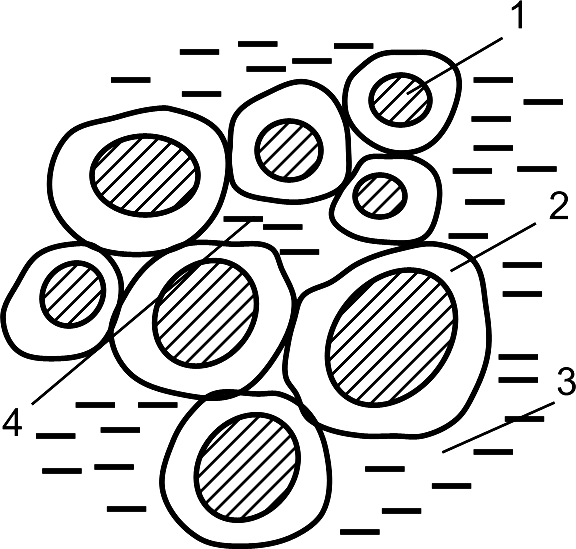
Hardening and structure of cement stone
From positions of the physical and
chemical mechanics P.Rebinder divides
the process of hardening of cement
paste on three stages:
a) Dissolution in water of unsteady
clinker phases and selection of crystals;
b) Formation of coagulate structure of
cement paste;
c) Growth and accretion of crystals.
Fig.3.5. Chart of coagulate
structure of cement paste
(from Y.Bagenov):
1 – grain of cement; 2 - shell; 3 – free
(mobile) water; 4 – entrapped
(immobile) water
59






A cement stone is pierced by
pores by a size from 0.1 to
100 µm.
Fig.3.6. The simplified model of
structure of cement stone
60





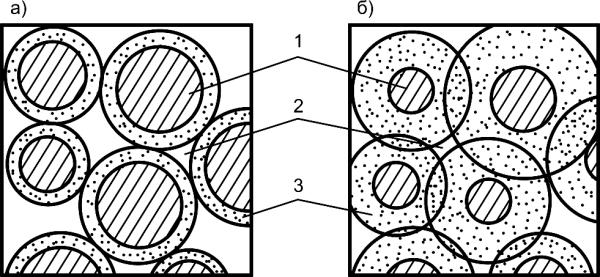
a
b
Fig.3.7. Change of capillary porosity in cement paste (stone) in the conditions of
proceeding hydration of cement:
a-Level of hydration = 0.3; b – Level of hydration = 0.7
1-not fully hydrated grain of cement; 2-capillary pores; 3-cement hydrate gel
61





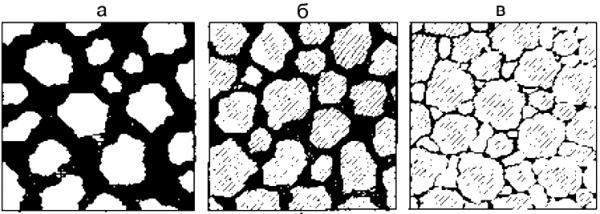
3.2. Influence of aggregates on forming
of concrete structure
Aggregates along with a cement stone form the concrete structure of
rocklike (conglomerate) mass.
a
b
c
Fig.3.8. Charts of concrete structure:
a –floating structure;
b – intermediate structure; c – contact structure
62






The important structural elements of concrete which determining physical
and mechanical properties are cracks.
In the real material always there is a plenty of microscopic cracks arising
up on technological or operating reasons. Cracks are characterized by a
length, width, radius, and front.
a
b
c
d
Fig.3.9. Models of cracks:
a – from Griffits; b – from P.Rebinder; c – from G.Bartenev (a, b, c – models of cracks
in ideally easily broken material); d – crack in the real rocklike material (from
G.Bartenev)
63





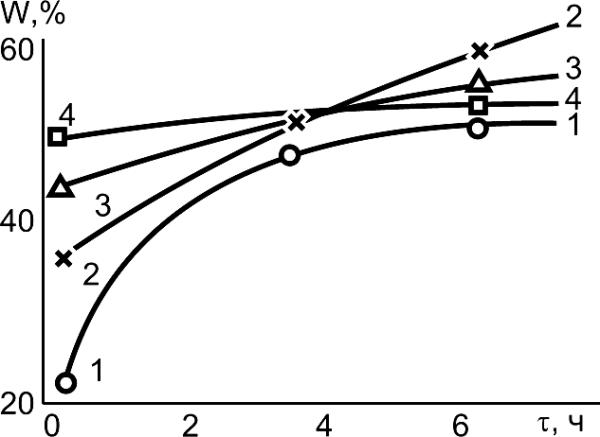
3.3. Influence of admixtures
on concrete structure forming
Influence of chemical admixtures
n, %io
draty h
Level of
Age, days
Fig.3.10. Kinetics of change of level of
hydration of cement silicate phase:
1-without admixtures; 2-calcium nitrite-nitrate
(3%); 3-calcium nitrite-nitrate–chloride (3%);
4-calcium chloride (3%)
64





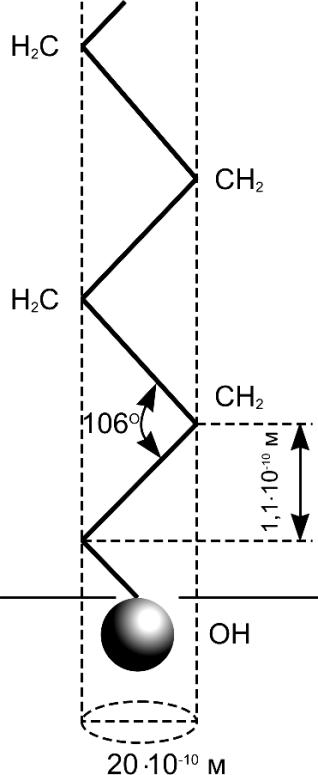
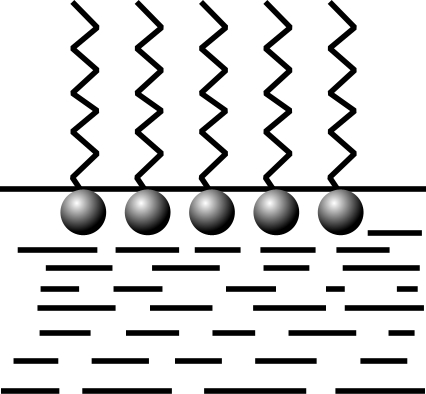
H2C
CH2
H2C
CH2
m
-10
⋅10
1.1
OH
Fig.3.12. Adsorbed layer of
surface-active substance at
the surface of a solid
20⋅10-10 m
Fig. 3.11. Chart of
molecule of surfaceactive substance
65





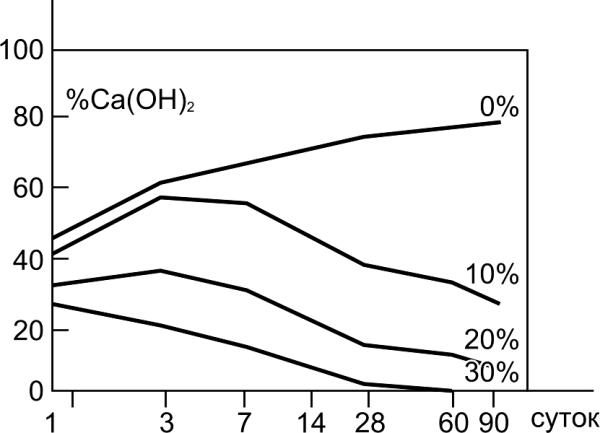
Influence of mineral admixtures
Finely divided mineral admixtures which are either pozzolanic or relatively
inert chemically make active influence on the processes of hardening and
forming of cement stone structure.
days
Fig.3.13. Change of the quantity of calcium
hydroxide Ca(OH)2 in solutions containing
metakaoline (finely divided product that results from
burning of kaolin)
66






3.4. Optimization of concrete structure
Concrete structure is a cover-up of its structure at a different levels from
atomic - molecular for separate components to macro-structure as
composition material.
a
b
Resource
Resource
Fig.3.14. Kinds of optimization tasks (from V.Voznesensky):
a – achievement of the set level of criterion of efficiency (J) at the minimum expense of
resources; b – achievement of maximal level of criterion of efficiency at the complete
expense of resources for achievement of purpose
67





Some structural criteria of properties of concrete
Structural criteria
Formula
Denotations
V
Density of
c, W ,Vair - absolute volumes of cement,
c
V
d =
water and air in the general volume of
concrete (d)
c
V + W + ai
V r
concrete, liters per cubic meter (l/m3)
General porosity
W − .
0 23αC + V
P
air
=
C - quantity of cement, kg/m3; α - level of
of concrete (P
s
s)
1000
cement hydration
Volume
concentration of
ρc – specific gravity of cement, kg per
C 1
cement paste С =
+
p
(W /C)
cubic liter (generally 3.1); W/C – water –
1000 ρc
(stone) in the
cement ratio
concrete (Cp)
68





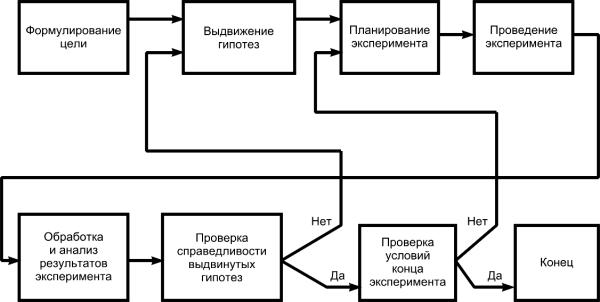
Decision of tasks of concrete structure optimization is possible by
mathematical methods supposing determination and analysis of
mathematical models.
Formulation of
Formulation of
Planning of
Conducting of
purpose
hypotheses
experiments
experiments
No
No
Treatment and
Verification of
Verification of
analysis of
rightness of the
terms of
Finish
experiments
formulated
hypotheses
Yes
experiments
Yes
finish
Fig.3.15. Strategy of determination of mathematical model
69









































































